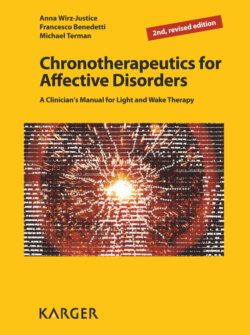Читать книгу Chronotherapeutics for Affective Disorders - M. Terman - Страница 6
На сайте Литреса книга снята с продажи.
Contents
ОглавлениеForeword
Acknowledgements
List of Abbreviations
Background
1 Introduction
1.1 Unmet Needs in the Treatment of Depression
1.2 Role of Biological Rhythms in Psychiatry
1.3 Principles of Circadian Timing
1.4 Principles of Sleep Regulation
1.5 Mood Level Varies with Time of Day and Duration of Wakefulness
1.6 Sleep Deprivation
1.7 How It All Began: Light Therapy for Seasonal Affective Disorder
1.8 Light Therapy – Beyond SAD
1.9 What Is Chronotherapeutics?
1.10 How Does Chronotherapeutics Work?
2 Individual Chronotherapeutic Elements: Light, Wake Therapy and Sleep Phase Advance
2.1 Efficacy of Bright Light Therapy for SAD
2.2 Timing of Bright Light Therapy
2.3 Dawn (and Dusk) Simulation Therapy
2.4 Efficacy of Bright Light Therapy for Non-Seasonal Depression
2.5 Dark Therapy
2.6 Wake Therapy
2.7 Phase Advance of the Sleep-Wake Cycle
2.8 Negative Air Ionisation
3 Integrative Chronotherapeutics: Combinations of Light, Wake Therapy and Sleep Phase Advance
3.1 A Note on Diagnostic Differences
3.2 Bright Light Augmentation of Antidepressant Drug Treatment
3.3 Wake Therapy Added to Medication
3.4 Wake and Light Therapy Added to Antidepressant Drugs or Mood Stabilisers
3.5 Wake, Light, and Sleep Phase Advance Therapy
3.6 Repeated Wake Therapy
Methods
4 Inpatient Procedures
4.1 Response Assessment and Monitoring
4.2 Light Therapy Timing and Duration
4.3 Exceptions to the Early Morning Light Rule for Bipolar 1 Disorder
4.4 Beginning with Light Therapy (+ Medication)
4.5 Wake Therapy + Light Therapy
4.6 Wake Therapy + Light Therapy + Sleep Phase Advance
4.7 Three Alternate Nights of Wake Therapy + Light Therapy + Freely Chosen Sleep Phase Advance
4.8 Variations on the Theme
4.9 Maintenance Treatment
4.10 Drug Tapering to Discontinuation
5 Practical Details for Wake Therapy
5.1 Which Patients Are Suitable?
5.2 Predictors of Response
5.3 Medication Allowances and Contraindications
5.4 What to Tell Patients
5.5 Setting and Structure for the Night Awake
5.6 Staff Monitoring
5.7 Nurses on the Night Shift
5.8 Nurses on the Day Shift after Wake Therapy
5.9 Structure of the Day After
5.10 Phase Advance of Sleep following Wake Therapy
5.11 The Doctor’s Tasks
5.12 Is One-Time Wake Therapy Enough?
5.13 Safety
5.14 Special Conditions
5.15 If There Is No Response
5.16 At the End of One Week of Chronotherapeutics
5.17 Relapse
5.18 In Conclusion
6 Practical Details for Light Therapy
6.1 Criteria for Light Box Selection
6.2 Using the Light Box
6.3 Side Effects of Light Therapy
6.4 Cautionary Notes about Bright Light Exposure
6.5 Before Beginning Light Therapy
6.6 In Conclusion
7 Outpatient Treatment Strategies
7.1 Light Therapy
7.2 A Daily Walk Outdoors
7.3 Wake Therapy
Indications
8 Range of Chronotherapeutic Indications
8.1 Antepartum Depression
8.2 Premenstrual Dysphoric Disorder
8.3 Eating Disorders
8.4 Attention Deficit/Hyperactivity Disorder
8.5 Dementia
8.6 Parkinson’s Disease
8.7 Shift Work and Jet Lag Disturbance
8.8 Other Psychiatric Disorders
8.9 Medical Applications
9 Light Therapy for Children and Adolescents
10 Light and Wake Therapy for Older Patients
11 The Visually Impaired: More Sleep Disturbances, More Depression
Pharmacology
12 Endogenous and Exogenous Melatonin
12.1 The Physiological Effects of Melatonin
12.2 Melatonin in Circadian Sleep-Wake Cycle Disturbances
12.3 Melatonin for Depression?
13 Drugs That Affect Rhythms (Chronobiotics)
13.1 Melatonin Agonists
13.2 Chronobiology of Lithium and Antidepressants
13.3 Clock Genes in Depression
13.4 Caffeine, Modafinil
Future Prospects
14 Social Rhythm Therapy
15 Chronobiology in Everyday Life
15.1 Know Your Chronotype
15.2 Timing of School and Work Schedules versus Sleep
15.3 Light and the Built Environment: Implications for Architecture
References
Subject Index
Appendix
Appendix.
1 Morningness-Eveningness self-assessment questionnaire (chronotype), with scoring and interpretation
2 Personal Inventory for Depression and SAD (diagnostic status), with scoring and interpretation
3 25-item expanded Hamilton Depression Scale with atypical symptoms (current level of depression), self assessment questionnaire with scoring and interpretation
4 6-item Hamilton Depression Scale, core symptoms (for monitoring short-term changes)
5 Daily sleep and medication logs, and mood and energy ratings
6 Chronotherapeutics information to outpatients and clinicians following hospital discharge
7 Center for Environmental Therapeutics clinical assessment tools
Authors
